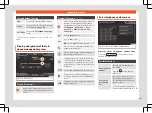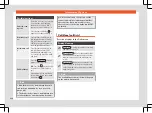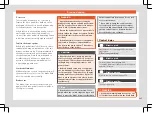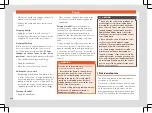
Driving
before switching it off, leave it idle for ap-
prox. 2 minutes in neutral.
Note
After switching off the engine, the cooling
fan may continue to operate in the engine
compartment for a few more minutes, even
with the ignition off. The radiator fan is au-
tomatically switched off.
“My Beat” Function
For vehicles with a convenience key there is
the “My Beat” function. This feature provides
an additional indication of the vehicle ignition
system.
When accessing the vehicle, e.g. by opening
the doors with the remote control, the
START ENGINE STOP
button flashes, calling at-
tention to the relevant starter system button.
Upon switching the ignition on/off, the light of
the
START ENGINE STOP
button flashes. With
the engine switched off, after a few seconds,
the
STOP ENGINE START
button stops flashing
and goes out.
With the engine running, the
START ENGINE STOP
button light stays on, indi-
cating that the engine is running. The time
that lapses between the moment the user
starts the engine with the
START ENGINE STOP
button and the lighting changes from flashing
to fixed will depend on specific engine size
characteristics. Upon switching the ignition
off with the
START ENGINE STOP
button, it starts
flashing again.
In vehicles
with the Start-Stop system
, the
“My Beat” function also offers additional in-
formation:
●
When the engine stops during the Stop
phase, the light of the
START ENGINE STOP
but-
ton stays on, since, even though the engine is
off, the Start-Stop system is active.
●
When the engine cannot be stated again
with the Start-Stop system,
needs to be started manually, the
START ENGINE STOP
button flashes to indicate
this fact.
Braking and parking
Information on the brakes
New brake pads
For the first 400 km (250 miles), new brake
pads have not yet reached their maximum
braking capacity, and need to be “run in” first.
However, you can compensate for the slightly
reduced braking effect by applying more
pressure on the brake pedal. Avoid overload-
ing the brakes while running them in.
Wear
The rate of wear on the
brake pads
depends
a great deal on how you drive and the condi-
tions in which the vehicle is operated. This is a
particular problem in urban traffic and short
stretches, or with very sporty driving.
Depending on the speed, the braking force
and the environmental conditions (for exam-
ple, the temperature, air humidity, etc.) noises
may be produced on braking.
Wet roads or road salt
In certain situations (for example, on driving
through flooded areas, in severe downpours
or after washing the vehicle) the braking ac-
tion could be delayed if the discs and pads
are damp, or frozen in winter. In this case the
brakes should be “dried” by pressing the
brake pedal several times.
At high speed and with the windscreen wipers
activated, the brake pads will briefly touch
the brake discs. This takes place, although
unnoticeable to the driver, at regular intervals
to improve the response time of the brakes
when they are wet.
The effectiveness of the brakes can also be
temporarily reduced if the vehicle is driven for
some distance without using the brakes when
there is a lot of salt on the road in winter. The
layer of salt that accumulates on the discs
and pads can be removed by gently apply-
ing the brakes a few times.
246
Summary of Contents for Ateca 2018
Page 1: ...Owner s manual SEAT Ateca 575012720BG Inglés 575012720BG 07 18 SEAT Ateca Inglés 07 18 ...
Page 105: ......
Page 106: ...Operation Fig 121 Instruments and controls 104 ...
Page 390: ...Technical data Dimensions Fig 314 Dimensions Fig 315 Angles and ground clearance 388 ...
Page 392: ......
Page 409: ......
Page 410: ......
Page 412: ...Owner s manual SEAT Ateca 575012720BG Inglés 575012720BG 07 18 SEAT Ateca Inglés 07 18 ...
















































